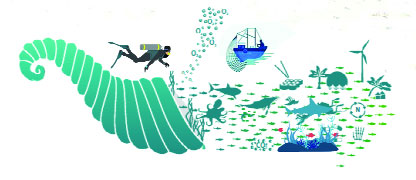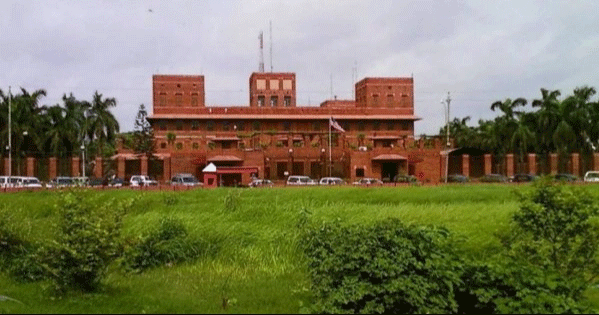Bangladesh fails to tap blue economy potentials
–Fear in hilsa production, possibilities of tourism
-Deep-sea fishing capability not achieved
Staff Correspondent : Due to the lack of capacity of Bangladeshi vessels to extract fish from the deep-sea area and lack of coordination of initiatives by the state, the extraction of pelagic fish resources from the vast ocean area is being disrupted. Even after 50 years of independence, Bangladesh has yet to conduct any survey of marine resources beyond 100 meters depth. As a result, Bangladesh has failed to tap the opportunity of highly potentials of blue economy.
In July 2020, the Ministry of Fisheries and Livestock took up a pilot project for the extraction of tuna and similar pelagic fish in the deep sea at a cost of Tk 61.06 crore. Although there is a plan to procure three long liner type fishing vessels for deep sea tuna fishing, the initiative has not yet seen the light of day. It is alleged that fishermen from two neighboring countries (India and Sri Lanka) have been illegally entering the deep waters of the Bay of Bengal and looting large quantities of fish.
Today is the second part of a three-part series of reports on various possibilities of the Sunil economy around the Bay of Bengal.
Hasan Ahmed Chowdhury, the former director of the Sustainable Coastal and Marine Fisheries Project and guest teacher researcher at Bangabandhu Sheikh Mujibur Rahman Maritime University told that our fishermen cannot go deeper than 60 meters to catch fish. Private commercial vessels do not fish deeper than 100 meters despite having the capacity. As a result, Bangladesh has not made any promising progress or success in catching tuna in the deep sea. But our neighboring countries India, Sri Lanka and Maldives are earning billions of dollars only by exporting tuna fish.
How far deep sea fishing?
Bangladesh became a member of the Indian Ocean Tuna Commission (IOTC) in 2018. Through which Bangladesh got the right to fish in international waters. As a member country, Bangladesh has to pay $70 thousand (Tk 77 lakh) to the organization every year. But due to lack of capacity, Bangladesh has not been able to catch fish in international waters so far.
Former Director of Marine Fisheries Department, Chittagong. Sharif Uddin said that 17 companies were allowed to import vessels for tuna and tuna fishing in addition to the state initiative. But those companies are not interested in investing in this sector.
But ‘due to the double policy of the government, it is not possible to catch tuna or pelagic fish in the deep sea’ – this is what Bangladesh Marine Fisheries Association general secretary SK Abid Hussain thinks.
He said, according to the policy, the cost of importing the vessels required for fishing in the sea beyond 200 meters depth will be huge cost. But till now the government could not even conduct a survey there. So how can businessmen invest such huge sums of money in importing ships?
According to SK Abid Hussain, the government is asking traders to import vessels longer than 55 meters for tuna fishing. However, three vessels are being purchased for government projects in this sector of only 25 meters in length. Why this discrimination? If we were also allowed to catch tuna with that quality ship, the country would have progressed a lot in fishing. Besides, I think it will be timelier if a public-private partnership initiative is taken to harvest pelagic fish like tuna.
However, Anisur Rahman Talukder, Additional Director General of the Directorate of Fisheries, is sounding hopeful. He told that the purchase of long liner is going through a long process due to various official complications. By next March, the purchase of two long liners for carrying out deep sea tuna survey work will be completed.
Concern about hilsa
Hilsa is now a global resource. 1 percent of Bangladesh’s national GDP comes from hilsa. More than 24 lakh people in the country make a living based on hilsa.
Bangladesh is the top country in the extraction of hilsa. In the fiscal year 2008-09, the extraction of hilsa was 2.98 million metric tons. Which has increased to 5.71 lakh metric tons in the financial year 2022-23. In the last 15 years, the production of hilsa has increased by almost 92 percent.
Haji Mohammad Ali, president of Chittagong’s Traditional Fishery Ghat Traders Association, said that after the start of the new season, an average of 1,000 tons of hilsa are being caught on Chittagong coast every day. Among them, more than 500 tons of hilsa are sold in the Fishery Ghat alone. Moreover, at least 500 tons of hilsa are unloaded daily at Sadarghat, Rashmanighat, Anandabazar, North Kattali, Dakshin Kattali and Akmal Ali Ghat.
However, he also thinks that the national fish hilsa is in danger of disappearing forever from Bangladesh due to various reasons including water pollution and shipping crisis.
The impact assessment report of a project titled ‘Conservation of Jatka, Fishermen’s Alternative Resources and Research (Components A and B)’ states that waste discharged from cities and factories along the hilsa-rich Padma, Meghna and other rivers is directly mixed with river water. As a result, the water quality of those rivers is gradually becoming unsuitable for the habitat of aquatic animals including fish. If this continues, hilsa may stop breeding in the waters of Bangladesh and choose new fields elsewhere.
Researcher Hasan Ahmed Chowdhury said that 60 percent of the fish extracted from the sea is Hilsa. Industrial trawlers are overfishing the hilsa in the deep sea, and as a result there is also concern about hilsa. Hilsa is a highly migratory fish. When there is ecological problem in one place, they change their habitat and move to another place. There was a negative impact on Hilsa production in Bangladesh during 2002-03.
He said, if only Sundarbans could be reserved for fish, it could be developed as a sanctuary, then there would not be a crisis of fish reproduction and ecology in the coastal areas of the country.
Coastal and marine tourism
Tourism is a huge global business, creating new jobs and reducing poverty. Bangladesh has the longest continuous beaches in the world with a coastline of 711 km. However, most of the tourist spots in the coastal and marine areas of Bangladesh are still unsuitable for domestic and foreign tourists. Coastal tourism has seen some success in a few spots including Cox’s Bazar, Teknaf and St. Martin’s Island, but marine tourism is still largely neglected.
Tourism was recognized as an industry in 1999. But no sustainable tourism initiatives based on environmental and biodiversity protection and financial-socio-cultural participation of local communities have been undertaken so far.
Chittagong University (CHB) Institute of Marine Sciences and Fisheries Professor Dr. Md. M. Maruf Hossain told that out of the total 25 bio-environmental zones in Bangladesh, 11 are located in coastal areas. These regions have 10 wildlife sanctuaries, 5 national parks and 17 fish sanctuaries. These important ecological and biodiversity-rich areas of the country’s coastal and marine regions can also be developed as tourist centers.
Former Minister of State for Civil Aviation and Tourism M Mahbub Ali said that an integrated tourism zone will be developed with Kuakata of Patuakhali, Taltali and Patharghata of Barguna to enrich the tourism of the coastal area. Moreover, initiatives have been taken to launch cruise services by sea with three neighboring countries, India, Maldives and Sri Lanka. For this purpose, three cruise ships are being built at a total cost of Tk 231.77 crores.
President Joe Biden tests positive for COVID-19 while campaigning in Las Vegas, has ‘mild symptoms’
International Desk: President Joe Biden tested positive for COVID-19 while traveling Wedne…








